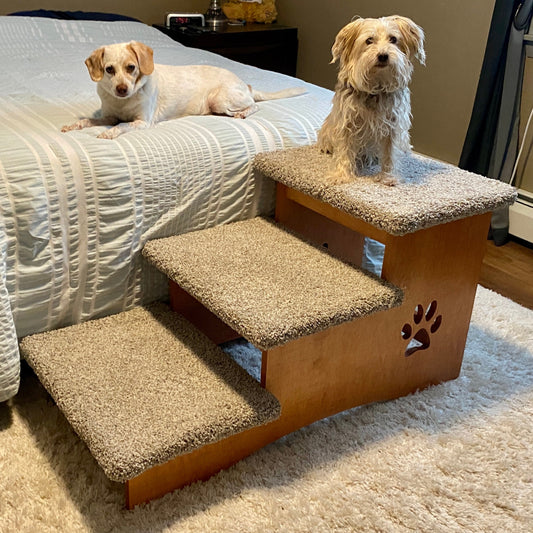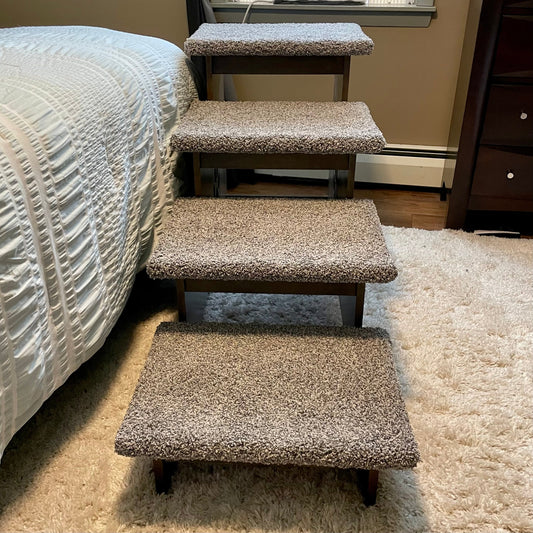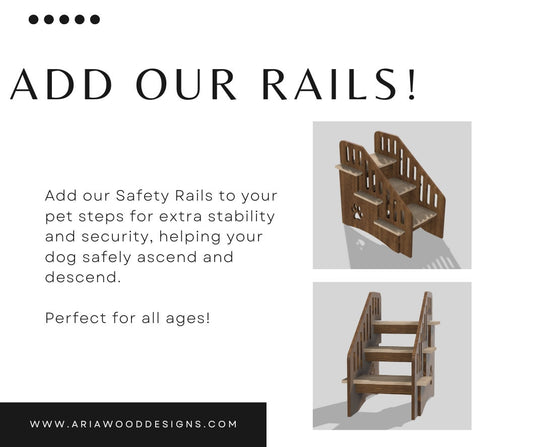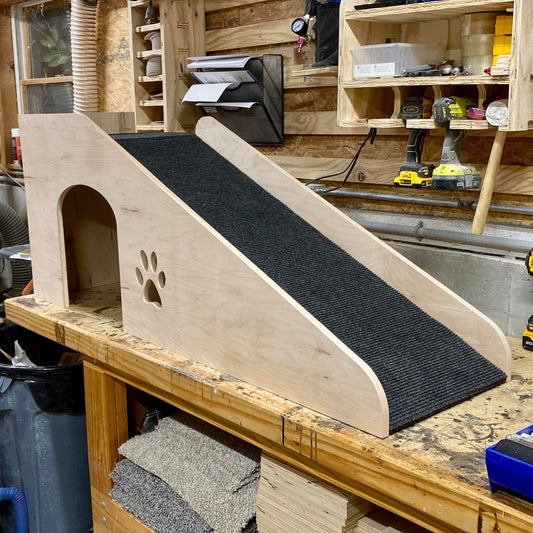Watching your beloved pup struggle to jump onto the couch can be heartbreaking. Maybe they're getting older and their joints aren't what they used to be. Perhaps they're a smaller breed that simply can't make the leap. Or you might be dealing with a recovering pet who needs to avoid high-impact movements during crate rest.
A dog ramp for your couch offers the perfect solution. These ingenious devices provide your furry best friend with a gentle, gradual path to their favorite spot on the sofa—no more risky jumps or painful landings. But with so many options available, from adjustable ramps to sturdy wooden stairs, choosing the right one can feel overwhelming.
This comprehensive guide will walk you through everything you need to know about dog ramps for couches. You'll discover the key features that matter most, learn when ramps work better than stairs, and find practical tips for helping your pet adapt to their new mobility aid. By the end, you'll have all the information needed to make an informed decision that keeps your four-legged family member comfortable and your furniture accessible.

Understanding the Difference: Dog Ramps vs Dog Stairs
Before diving into specific products, it's crucial to understand when a ramp serves your pet better than stairs, and vice versa.
When Dog Ramps Excel
Dog ramps work particularly well for pets recovering from surgery or dealing with joint issues. The gradual incline puts less stress on aging joints compared to the step-up motion required for stairs. If your pup is on crate rest following an injury, veterinarians often recommend ramps because they eliminate the jarring impact of jumping.
Ramps also benefit anxious or fearful dogs who might feel intimidated by stairs. The continuous surface feels more secure under their paws, providing better confidence as they navigate to the couch.
When Stairs Make More Sense
Some dogs, particularly those with good mobility, actually prefer stairs. The defined steps give them clear landmarks for placement, which can be especially helpful for older dogs with vision issues. Stairs typically require less floor space than ramps, making them ideal for tight living rooms or bedrooms where space is at a premium.
Many pet owners find that stairs blend better with home decor since they resemble miniature furniture rather than medical equipment.
Key Features to Look for in a Dog Ramp for Couch
Surface Traction and Safety
Good traction is non-negotiable when selecting a dog ramp. Look for surfaces with carpet, non-slip treads, or textured materials that prevent sliding. Slippery surfaces can create fear and potentially cause injuries, undermining the ramp's purpose entirely.
The best ramps feature pet-friendly carpeting that's soft on paws while providing excellent grip. This material should be durable enough to withstand regular use and resist stains from occasional accidents.
Weight Capacity and Sturdy Construction
Your ramp needs to support your dog's full weight without wobbling or flexing. Check the manufacturer's weight limits and choose a ramp rated well above your pet's current weight. This extra capacity ensures stability and accounts for the dynamic forces created when your dog walks up or down.
Quality construction materials make a significant difference. Solid wood ramps with proper joinery techniques, like pocket-hole construction, offer superior durability compared to lightweight alternatives that may wobble or break over time.
Appropriate Dimensions
The ramp's length determines its steepness. Longer ramps create gentler inclines that are easier for dogs to navigate, especially those with mobility challenges. However, longer ramps also require more floor space in your room.
Width matters too. Your ramp should be wide enough for your dog to walk comfortably without feeling like they might fall off the sides. Large breeds need proportionally wider ramps than small dogs.
Height Adjustability
Adjustable ramps offer versatility if you plan to use them with different furniture pieces. Some models allow you to modify the height to work with various couches, beds, or other surfaces throughout your house.
Selecting the Right Size for Your Dog and Furniture
Measuring Your Couch Height
Start by measuring from the floor to the top of your couch cushions. This measurement determines the minimum height your ramp needs to reach. Add a few inches to account for your dog's comfort when stepping onto the furniture.
Calculating Ramp Length
A general rule suggests that ramps should be 4 times longer than they are tall for comfortable use by most dogs. For a 20-inch high couch, you'd want approximately an 80-inch long ramp. Dogs with severe mobility issues may need even gentler slopes.
Considering Your Dog's Size and Breed
Small breeds like Chihuahuas or Yorkies need different ramp specifications than large dogs like Golden Retrievers. Tiny dogs can navigate steeper inclines more easily but need narrower ramps that don't overwhelm them. Large breeds require wider, more gradually sloped ramps to accommodate their size and weight.
Senior dogs, regardless of size, typically benefit from gentler inclines and extra-wide surfaces that provide more stability and confidence.
Installation and Setup Tips
Positioning for Success
Place your ramp so it approaches the couch at a natural angle. Avoid positioning it directly perpendicular to the furniture, which can feel awkward for dogs to navigate. A slight diagonal approach often works better.
Ensure the ramp base sits on a stable, level surface. Carpet can provide good grip for the ramp base, while hardwood floors might require additional grip pads to prevent sliding.
Making It Non-Slip
Even ramps with good traction can benefit from additional safety measures. Rubber mats placed under the base prevent the entire ramp from sliding across smooth floors. Some owners add extra grip tape to particularly smooth areas of the ramp surface.
Creating Adequate Space
Allow plenty of room around both ends of the ramp. Your dog needs space to approach comfortably and shouldn't feel cramped when using it. Consider how the ramp affects traffic flow in your room and adjust furniture placement if necessary.
Training Your Puppy to Use the Ramp
Introduction Phase
Start by placing the ramp on a flat surface with no incline. Let your curious pup investigate and walk across it at ground level with no rail. Reward them with treats and praise for any interaction with the ramp, building positive associations.
Gradual Height Introduction
Once your dog walks confidently across the flat ramp, gradually introduce height. Start with just a few inches of elevation, using books or blocks under one end. Slowly increase the angle over several days or weeks, depending on your pet's comfort level.
Using Positive Reinforcement
Never force your dog onto the ramp, as this creates negative associations that can take weeks to overcome. Instead, use high-value treats, favorite toys, or enthusiastic praise to encourage exploration and use.
Some dogs respond well to having their human walk up the ramp first, demonstrating that it's safe and fun. Others prefer to figure it out independently with gentle encouragement from the side.
Maintenance and Longevity
Regular Cleaning
Pet-friendly carpeting on ramps requires regular vacuuming to remove hair, dirt, and debris. Spot-clean stains promptly to prevent odors from developing. Some carpet materials are machine washable, making maintenance easier.
Checking for Wear
Inspect your ramp regularly for signs of wear, particularly at high-stress points like joints and the top edge where your dog steps onto furniture. Look for loose screws, worn carpet, or any wobbling that might indicate structural issues.
Storage Considerations
If you need to store your ramp when not in use, ensure it's kept in a dry location away from extreme temperatures. Some ramps fold or disassemble for easier storage, while others are designed as permanent furniture pieces.

Special Considerations for Senior Dogs
Joint Health Support
Senior dogs often develop arthritis or other joint issues that make jumping painful or impossible. A well-designed ramp can significantly improve their quality of life by maintaining access to favorite resting spots.
Consider ramps with extra-wide surfaces and very gradual inclines for older pets. The gentler the slope, the less stress on aging joints.
Confidence Building
Older dogs sometimes become anxious about mobility challenges. Take extra time during training, moving at your senior pet's pace. Consistent routines help build confidence—try to keep the ramp in the same position and encourage use at regular times.
Veterinary Consultation
If your senior dog suddenly needs assistance reaching furniture they previously accessed easily, consult your veterinarian. Mobility changes can indicate underlying health issues that require professional attention.
Budget-Friendly Options vs Premium Choices
DIY Solutions
Crafty pet owners sometimes build custom ramps using plywood, carpet, and basic hardware. While this can save money, ensure your DIY creation meets safety standards for weight capacity and stability. Professional woodworking skills help create secure joints and proper angles.
Mid-Range Commercial Options
Many pet stores offer reasonably priced ramps made from lightweight materials like plastic or aluminum. These work well for smaller dogs but may lack the stability needed for larger breeds or long-term use.
Premium Wooden Ramps
High-quality wooden ramps, like those from specialized manufacturers, offer superior durability and often better aesthetics. They're typically more expensive but provide better long-term value through their construction quality and appearance.
Premium options often include features like precision-cut components, professional finishes, and pet-friendly carpeting that's both comfortable and durable.
Frequently Asked Questions
How steep is too steep for a dog ramp?
Most dogs can comfortably use ramps with inclines up to 30 degrees, but gentler slopes around 20 degrees or less work better for senior pets or those with mobility issues. The specific angle depends on your dog's size, age, and physical condition.
Can I use the same ramp for multiple furniture pieces?
Adjustable ramps work well for multiple surfaces of different heights. However, fixed-height ramps designed for specific furniture typically offer better stability and ease of use for that particular application.
What if my dog refuses to use the ramp?
Patience and positive reinforcement usually overcome initial reluctance. Start with the ramp at minimal incline and reward any interaction. Some dogs take weeks to feel comfortable, especially if they're naturally cautious or have had bad experiences with mobility aids.
How do I know if the ramp is the right width?
Your dog should be able to walk up the ramp with their normal gait without their paws coming close to the edges. Small dogs need at least 12 inches of width, while large breeds often require 16 inches or more.
Are folding ramps as stable as fixed ones?
Quality folding ramps can be very stable when properly designed and constructed. However, fixed ramps typically offer superior stability since they have fewer moving parts and joints that could potentially fail or loosen over time.

Why Choose Aria Wood Designs for Dog Ramps?
When it comes to high-quality, stylish, and functional dog ramps, Aria Wood Designs stands out as a top choice. Specializing in custom wooden ramps that integrate seamlessly into your home's decor, Aria Wood Designs offers a perfect balance of form and function. Each ramp is handcrafted with care, ensuring durability and safety for your furry companion.
Aria Wood Designs prioritizes both your pet's needs and your aesthetic preferences. Their ramps are available in a variety of finishes, allowing you to choose one that complements your interior design. Additionally, their use of premium materials ensures that the ramps are long-lasting and sturdy, making them ideal for dogs of all breeds and sizes.
If you're looking for a well-crafted, visually appealing, and pet-safe solution, Aria Wood Designs is an excellent option worth considering. Visit their website to explore their offerings and find the perfect ramp for your dog.
Helpful Resources on Dog Ramps and Canine Mobility
-
American Kennel Club (AKC) - How To Help Your Senior Dog
Learn about the challenges senior dogs face and how tools like ramps can make their lives easier. -
Rover - Senior Dog Mobility Issues
This article explores the benefits of using dog ramps, including how they reduce strain on a dog’s joints. -
PetMD - Hip Dysplasia in Dogs
A deep dive into hip dysplasia, its symptoms, and how mobility aids like ramps can provide support. -
Whole Dog Journal - Tools for Dogs with Mobility Issue
A guide discussing various tools, including dog ramps, that help pets experiencing mobility difficulties. -
Ortho Dog - Supporting Dogs with Arthritis
Learn about arthritis in dogs and how ramps can help improve their day-to-day comfort and mobility. -
DogTime - Choosing the Best Dog Ramp
This resource outlines tips for selecting the right dog ramp for your pet’s size, age, and specific needs. -
Animal Wellness Magazine - Tips for Senior Dog Care
Offers advice on caring for senior dogs, including emphasizing the importance of ramps for their safety and health.
Making the Right Choice for Your Pet's Future
Selecting the perfect dog ramp for your couch involves balancing your pet's specific needs with practical considerations like space, budget, and aesthetics. The key lies in understanding your dog's physical capabilities, preferences, and any health challenges they face.
Remember that investing in a quality ramp now can prevent injuries and maintain your pet's independence as they age. The peace of mind that comes from knowing your furry friend can safely access their favorite spots makes the investment worthwhile.
Take time to research options, read reviews from other pet owners, and consider your long-term needs. A well-chosen ramp becomes an integral part of your home, supporting your pet's mobility and comfort for years to come.
Your dog's safety and comfort should guide every decision. Whether you choose a simple adjustable ramp or invest in a custom wooden solution, the right choice is the one that helps your best friend maintain their quality of life while keeping them safe and secure.









